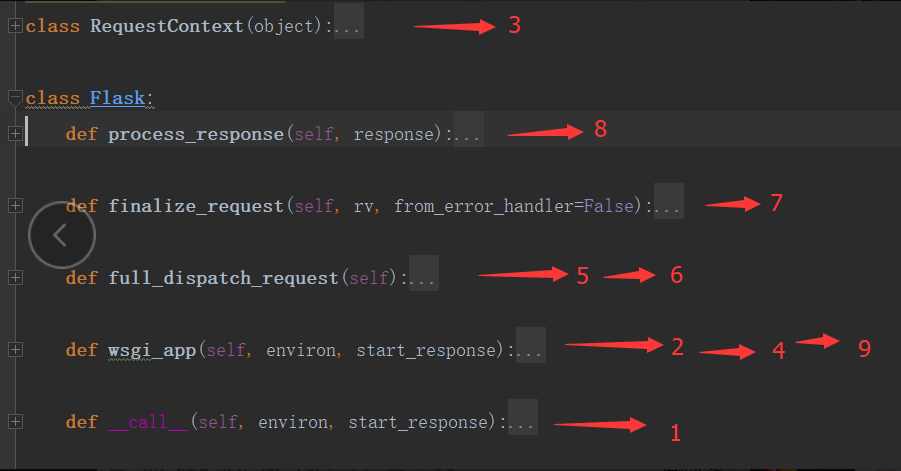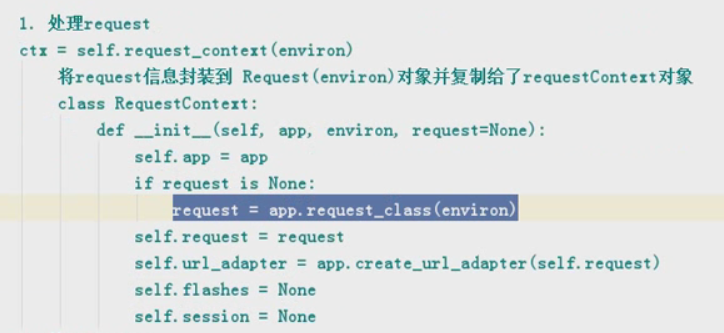session 的 源码
1.session 和 cookie 的 区别:
答: cookie 它是保存在浏览器的键值对。
session 它是保存在服务端的键值对。 它 依赖cookie 存在。
流程:
一个服务端, 一个客户端第一次来
服务端 去 客户端 发来的请求里的cookie 里面找一个 随机字符串。
新用户没有,服务端就会为客户端创建一个随机字符串,发到它的cookie里,并且保存到服务端。
下次这个客户端又来了,那么这次服务端就可以获取到了随机字符串。
根据这个随机字符串看看你以前有没有在session里面放数据。(对比)
如果数据更新,是会先更新到内存里面,请求返回到时候,在会把内存的数据保存的session。
session
{
pc随机字符串: {},
}
当请求第一次来,生成随机字符串,发给用户的cookie,保存到session字段中。(其实就是调用stark(中介),将随机字符串和对应的值,放到local(房主)里)
以后去取的时候,top就行了。
请求处理完毕,就将session持久化,存到数据库,存到redis,存到加密cookie中。
2.分析session源码:
1.请求刚进来先走Flask类的__call__方法。
2.用到类和方法。

3. 细分:
0.app.run() ==> run_simple(host, port, self, **options) #第一: hold 住 对象过来就执行 __call__方法.

1.__call__ 跳入:

2.self.wsgi_app 跳入:
def wsgi_app(self, environ, start_response):
2.1 如何封装? push 跳入

3. push跳入之后

_request_ctx_stack跳入: request 和 session 都会放入local 中。

3.1 刚开始处理session

4.self.wsgi_app. 处理函数

full_dispatch_request()跳入:
5.full_dispatch_request

6.full_dispatch_request。对返回值进行封装,请求完了之后 after。

finalize_request跳入;
7.finalize_request

process_response跳入:
8.process_response

9. self.wsgi_app 里。

4.超级细分:
三部曲:
1. 上下文的处理: 他做的是: 把request,session 的请求相关信息放到local里。(赋值给RequestContext对象)
首先.
if __name__ == '__main__':app.run()app.__call__() #第一
ps: __call__ 跳入
def __call__(self, environ, start_response):"""Shortcut for :attr:`wsgi_app`.""" return self.wsgi_app(environ, start_response) #第二:请求开始的地方,也是结束的地方
ps: wsgi_app 跳入
def wsgi_app(self, environ, start_response): #第三'''{"唯一标识":{'stack':[ResquestContext对象(request,session)]}}'''#第四: 开始之前做的事情。(两件事:处理了request,session),将这两个数据封装到local中。ctx = self.request_context(environ) #将request信息封装到Request(environ)对象并赋值给了 RequestContext对象 ctx.push()error = Nonetry:try:response = self.full_dispatch_request() #第七:执行:before装饰器函数,视图函数:after装饰器函数except Exception as e: #如果请求出现异常error = eresponse = self.handle_exception(e) # 信号6: 第2/3/4/5/got_request_exceptionexcept:error = sys.exc_info()[1]raisereturn response(environ, start_response)finally:if self.should_ignore_error(error):error = Nonectx.auto_pop(error) # 结束了 #ctx是request-Context对象 信号7: 里面做了 第6信号:
ps: request_context 跳入
def request_context(self, environ):return RequestContext(self, environ)
ps: RequestContext 跳入
class RequestContext(object):def __init__(self, app, environ, request=None):self.app = appif request is None: #如果request 为空request = app.request_class(environ) # app.request_class就是request对象,app就是flask对象self.request = requestself.url_adapter = app.create_url_adapter(self.request)self.flashes = Noneself.session = None# Request contexts can be pushed multiple times and interleaved with# other request contexts. Now only if the last level is popped we# get rid of them. Additionally if an application context is missing# one is created implicitly so for each level we add this informationself._implicit_app_ctx_stack = []# indicator if the context was preserved. Next time another context# is pushed the preserved context is popped.self.preserved = False# remembers the exception for pop if there is one in case the context# preservation kicks in.self._preserved_exc = None# Functions that should be executed after the request on the response# object. These will be called before the regular "after_request"# functions.self._after_request_functions = []self.match_request()def _get_g(self):return _app_ctx_stack.top.gdef _set_g(self, value):_app_ctx_stack.top.g = valueg = property(_get_g, _set_g)del _get_g, _set_gdef copy(self):"""Creates a copy of this request context with the same request object.This can be used to move a request context to a different greenlet.Because the actual request object is the same this cannot be used tomove a request context to a different thread unless access to therequest object is locked... versionadded:: 0.10"""return self.__class__(self.app,environ=self.request.environ,request=self.request)def match_request(self):"""Can be overridden by a subclass to hook into the matchingof the request."""try:url_rule, self.request.view_args = \self.url_adapter.match(return_rule=True)self.request.url_rule = url_ruleexcept HTTPException as e:self.request.routing_exception = edef push(self):"""Binds the request context to the current context."""# If an exception occurs in debug mode or if context preservation is# activated under exception situations exactly one context stays# on the stack. The rationale is that you want to access that# information under debug situations. However if someone forgets to# pop that context again we want to make sure that on the next push# it's invalidated, otherwise we run at risk that something leaks# memory. This is usually only a problem in test suite since this# functionality is not active in production environments.top = _request_ctx_stack.top # 取值if top is not None and top.preserved:top.pop(top._preserved_exc)# Before we push the request context we have to ensure that there# is an application context.app_ctx = _app_ctx_stack.topif app_ctx is None or app_ctx.app != self.app:app_ctx = self.app.app_context() # 信号1: 把app放到 local里。app_ctx.push() # 信号2:AppContext(self)的push (里面做了:触发执行 第1信号:appcontext_pushed)self._implicit_app_ctx_stack.append(app_ctx) # 信号3: 把上面app_ctx对象加进来,以后可以取else:self._implicit_app_ctx_stack.append(None)if hasattr(sys, 'exc_clear'):sys.exc_clear()_request_ctx_stack.push(self) #第五:将requestContext对象(request,session)的引用,只要一修改,都修改了,添加到local中。# Open the session at the moment that the request context is# available. This allows a custom open_session method to use the# request context (e.g. code that access database information# stored on `g` instead of the appcontext).#self.session_interface.open_session(self, request) = self.app.open_session(self.request)#return self.session_interface.open_session(self, request)#return SecureCookieSessionInterface().open_session(sekf,request) 经过一段处理,session就不是None了self.session = self.app.open_session(self.request) #第六:刚开始处理session。self.app 表示:flask 对象if self.session is None: # self 表示:requestContext对象.请求一开始进来,为空self.session = self.app.make_null_session() # 走这里,最后还是指null_session_class = NullSession。def pop(self, exc=_sentinel):"""Pops the request context and unbinds it by doing that. This willalso trigger the execution of functions registered by the:meth:`~flask.Flask.teardown_request` decorator... versionchanged:: 0.9Added the `exc` argument."""app_ctx = self._implicit_app_ctx_stack.pop()try:clear_request = Falseif not self._implicit_app_ctx_stack:self.preserved = Falseself._preserved_exc = Noneif exc is _sentinel:exc = sys.exc_info()[1]self.app.do_teardown_request(exc) # 信号7。2: 第6信号 request_tearing_down# If this interpreter supports clearing the exception information# we do that now. This will only go into effect on Python 2.x,# on 3.x it disappears automatically at the end of the exception# stack.if hasattr(sys, 'exc_clear'):sys.exc_clear()request_close = getattr(self.request, 'close', None)if request_close is not None:request_close()clear_request = Truefinally:rv = _request_ctx_stack.pop()# get rid of circular dependencies at the end of the request# so that we don't require the GC to be active.if clear_request:rv.request.environ['werkzeug.request'] = None# Get rid of the app as well if necessary.if app_ctx is not None:app_ctx.pop(exc) # 信号8:pop属Appcontxt 跳入: 它做了触发了 第7信号 appcontext_tearing_downassert rv is self, 'Popped wrong request context. ' \'(%r instead of %r)' % (rv, self)def auto_pop(self, exc):if self.request.environ.get('flask._preserve_context') or \(exc is not None and self.app.preserve_context_on_exception):self.preserved = Trueself._preserved_exc = excelse:self.pop(exc) #信号7.1 跳入def __enter__(self):self.push()return selfdef __exit__(self, exc_type, exc_value, tb):# do not pop the request stack if we are in debug mode and an# exception happened. This will allow the debugger to still# access the request object in the interactive shell. Furthermore# the context can be force kept alive for the test client.# See flask.testing for how this works. self.auto_pop(exc_value)if BROKEN_PYPY_CTXMGR_EXIT and exc_type is not None:reraise(exc_type, exc_value, tb)def __repr__(self):return '<%s \'%s\' [%s] of %s>' % (self.__class__.__name__,self.request.url,self.request.method,self.app.name,)
ps: 这里,我们暂时先可以看下: session 和 request 一开进来都None。 接着,我们返回,从push 方法进入:
def wsgi_app(self, environ, start_response): #第三'''{"唯一标识":{'stack':[ResquestContext对象(request,session)]}}'''#第四: 开始之前做的事情。(两件事:处理了request,session),将这两个数据封装到local中。ctx = self.request_context(environ) #将request信息封装到Request(environ)对象并赋值给了 RequestContext对象ctx.push()
ps: push 跳入,看看里面都执行了什么?
_request_ctx_stack = LocalStack()
ps: LocalStack() 跳入
def __init__(self):self._local = Local()
ps: Local () 跳入
执行setattr 方法,
def __setattr__(self, name, value):ident = self.__ident_func__()storage = self.__storage__try:storage[ident][name] = valueexcept KeyError:storage[ident] = {name: value}
返回:
#self.session_interface.open_session(self, request) = self.app.open_session(self.request)#return self.session_interface.open_session(self, request)#return SecureCookieSessionInterface().open_session(sekf,request) 经过一段处理,session就不是None了self.session = self.app.open_session(self.request) #第六:刚开始处理session。self.app 表示:flask 对象if self.session is None: # self 表示:requestContext对象.请求一开始进来,为空self.session = self.app.make_null_session() # 走这里,最后还是指null_session_class = NullSession。
ps: open_session 跳入
def open_session(self, request):return self.session_interface.open_session(self, request)
ps: session_interface 跳入
session_interface = SecureCookieSessionInterface()
ps: SecureCookieSessionInterface() 跳入
class SecureCookieSessionInterface(SessionInterface):
#: the salt that should be applied on top of the secret key for the
#: signing of cookie based sessions.
salt = 'cookie-session'
#: the hash function to use for the signature. The default is sha1
digest_method = staticmethod(hashlib.sha1)
#: the name of the itsdangerous supported key derivation. The default
#: is hmac.
key_derivation = 'hmac'
#: A python serializer for the payload. The default is a compact
#: JSON derived serializer with support for some extra Python types
#: such as datetime objects or tuples.
serializer = session_json_serializer
session_class = SecureCookieSession #其实,最后返回的还是个字典的形式
ps: SecureCookieSession跳入
class SecureCookieSession(CallbackDict, SessionMixin):"""Base class for sessions based on signed cookies."""def __init__(self, initial=None):def on_update(self):self.modified = TrueCallbackDict.__init__(self, initial, on_update)self.modified = False
ps: CallbackDict 跳入
class CallbackDict(UpdateDictMixin, dict): #dict 字典"""A dict that calls a function passed every time something is changed.The function is passed the dict instance."""
ps: 从这可以看出,它最后继承是 dict 字典。
返回:
return self.session_interface.open_session(self, request) ps: 从open_session 进入
def open_session(self, app, request):s = self.get_signing_serializer(app) # 加密if s is None:return Noneval = request.cookies.get(app.session_cookie_name) #request:请求的对象,去cookie中获取session作为key对应的值。if not val: #没有return self.session_class() #返回session_classmax_age = total_seconds(app.permanent_session_lifetime)try:data = s.loads(val, max_age=max_age) #序列化解密return self.session_class(data)except BadSignature:return self.session_class()
ps: 进行一系列处理,最后的返回的 session_class 是以字典形式存的。
小结: 以上的流程就是上下文处理的过程。
简单的来说,上下文处理做的就是把请求的数据给封装到了 local 里。
2. 视图函数处理
首先:
def wsgi_app(self, environ, start_response): #第三'''{"唯一标识":{'stack':[ResquestContext对象(request,session)]}}'''#第四: 开始之前做的事情。(两件事:处理了request,session),将这两个数据封装到local中。ctx = self.request_context(environ) #将request信息封装到Request(environ)对象并赋值给了 RequestContext对象 ctx.push()error = Nonetry:try:response = self.full_dispatch_request() #第七:执行:before装饰器函数,视图函数:after装饰器函数except Exception as e: #如果请求出现异常error = eresponse = self.handle_exception(e) # 信号6: 第2/3/4/5/got_request_exceptionexcept:error = sys.exc_info()[1]raisereturn response(environ, start_response)finally:if self.should_ignore_error(error):error = Nonectx.auto_pop(error) # 结束了 #ctx是request-Context对象 信号7: 里面做了 第6信号:
ps: full_dispatch_request 跳入
def full_dispatch_request(self):"""Dispatches the request and on top of that performs requestpre and postprocessing as well as HTTP exception catching anderror handling... versionadded:: 0.7"""self.try_trigger_before_first_request_functions() #第八: 执行@before_first_request 装饰的所有函数try:request_started.send(self) #信号4: 请求刚进来执行,触发了 第2信号:request_started.rv = self.preprocess_request() #第九: 执行 @before_request 装饰的所有函数if rv is None:rv = self.dispatch_request()except Exception as e:rv = self.handle_user_exception(e)return self.finalize_request(rv) #第十: 执行@after_request 装饰的所有函数:session保存
ps: finalize_request 跳入
def finalize_request(self, rv, from_error_handler=False):"""Given the return value from a view function this finalizesthe request by converting it into a response and invoking thepostprocessing functions. This is invoked for both normalrequest dispatching as well as error handlers.Because this means that it might be called as a result of afailure a special safe mode is available which can be enabledwith the `from_error_handler` flag. If enabled, failures inresponse processing will be logged and otherwise ignored.:internal:"""response = self.make_response(rv)try:response = self.process_response(response) #第11: 进入process_responserequest_finished.send(self, response=response) #信号5:第5信号 request_finished 执行之前,视图函数如果有模板语法,会先执行:第3,4,信号 : before_render_template template-renderedexcept Exception:if not from_error_handler:raiseself.logger.exception('Request finalizing failed with an ''error while handling an error')return response
ps: process_session 跳入
def process_response(self, response):"""Can be overridden in order to modify the response objectbefore it's sent to the WSGI server. By default this willcall all the :meth:`after_request` decorated functions... versionchanged:: 0.5As of Flask 0.5 the functions registered for after requestexecution are called in reverse order of registration.:param response: a :attr:`response_class` object.:return: a new response object or the same, has to be aninstance of :attr:`response_class`."""ctx = _request_ctx_stack.topbp = ctx.request.blueprintfuncs = ctx._after_request_functionsif bp is not None and bp in self.after_request_funcs:funcs = chain(funcs, reversed(self.after_request_funcs[bp]))if None in self.after_request_funcs:funcs = chain(funcs, reversed(self.after_request_funcs[None]))for handler in funcs: # 执行 @after_request 装饰的所有函数response = handler(response)if not self.session_interface.is_null_session(ctx.session): #最后处理session self.save_session(ctx.session, response)return response
ps: save_session 跳入
def save_session(self, session, response):"""Saves the session if it needs updates. For the defaultimplementation, check :meth:`open_session`. Instead of overriding thismethod we recommend replacing the :class:`session_interface`.:param session: the session to be saved (a:class:`~werkzeug.contrib.securecookie.SecureCookie`object):param response: an instance of :attr:`response_class`"""return self.session_interface.save_session(self, session, response)
ps: save_session 跳入
3. 保存,返回
def save_session(self, app, session, response):domain = self.get_cookie_domain(app)path = self.get_cookie_path(app)# Delete case. If there is no session we bail early.# If the session was modified to be empty we remove the# whole cookie.if not session:if session.modified:response.delete_cookie(app.session_cookie_name,domain=domain, path=path)return# Modification case. There are upsides and downsides to# emitting a set-cookie header each request. The behavior# is controlled by the :meth:`should_set_cookie` method# which performs a quick check to figure out if the cookie# should be set or not. This is controlled by the# SESSION_REFRESH_EACH_REQUEST config flag as well as# the permanent flag on the session itself.if not self.should_set_cookie(app, session):returnhttponly = self.get_cookie_httponly(app)secure = self.get_cookie_secure(app)expires = self.get_expiration_time(app, session)val = self.get_signing_serializer(app).dumps(dict(session)) #内存中的session,字典进行加密,也有序列化 response.set_cookie(app.session_cookie_name, val,expires=expires, httponly=httponly,domain=domain, path=path, secure=secure) #存到加密的cookie里。
ps: 最后 加密,存到cookie里 返回: 执行 finally
ctx.auto_pop(error) # 结束了 #ctx是request-Context对象 信号7: 里面做了 第6信号:
ps: auto_pop 跳入
def auto_pop(self, exc):if self.request.environ.get('flask._preserve_context') or \(exc is not None and self.app.preserve_context_on_exception):self.preserved = Trueself._preserved_exc = excelse:self.pop(exc) #信号7.1 跳入
ps: self.pop(exc) 跳入
def pop(self, exc=_sentinel):"""Pops the request context and unbinds it by doing that. This willalso trigger the execution of functions registered by the:meth:`~flask.Flask.teardown_request` decorator... versionchanged:: 0.9Added the `exc` argument."""app_ctx = self._implicit_app_ctx_stack.pop()try:clear_request = Falseif not self._implicit_app_ctx_stack:self.preserved = Falseself._preserved_exc = Noneif exc is _sentinel:exc = sys.exc_info()[1]self.app.do_teardown_request(exc) # 信号7。2: 第6信号 request_tearing_down# If this interpreter supports clearing the exception information# we do that now. This will only go into effect on Python 2.x,# on 3.x it disappears automatically at the end of the exception# stack.if hasattr(sys, 'exc_clear'):sys.exc_clear()request_close = getattr(self.request, 'close', None)if request_close is not None:request_close()clear_request = Truefinally:rv = _request_ctx_stack.pop() #把ContentText对象 POP 出来
ps: 把ContentText对象 POP 出来
结束。

:重读vue电商网站3之登录页面总结el-form 组件问题)




:重读vue电商网站5之登录页面总结如何进行表单验证)

)

:重读vue电商网站6之如何重置表单)

)

:重读vue电商网站7之登录预校验)



:重读vue电商网站8之设置弹框提示组件)
